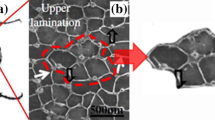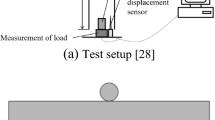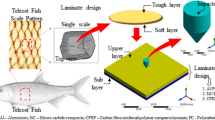Abstract
The elytra can protect the body and hind wings of the beetle by absorbing the impact energy and resisting damage from outside loading. In this paper, we firstly observed the microstructures of hollow column and pole canal in the ladybird beetle elytra and revealed the relationship between them. A bionic energy-absorbing structure inspired by ladybird beetle elytra was proposed, and a micron-scale finite element model was built. The mechanical characteristics of bionic structures with and without poles under axial impact loading were investigated by numerical simulations. It could be obtained that the poles could absorb the impact energy by its deformation. Then the parameter studies including the different impact velocities, the different column diameters, and the different thickness of cuticle were carried out. This parameter study shows that geometric variations and impact velocity have a significant influence on mechanical properties.








Similar content being viewed by others
References
Naleway SE, Porter MM, McKittrick J, Meyers MA (2015) Structural design elements in biological materials: application to bioinspiration. Adv Mater 27:5455–5476
Naleway SE, Taylor JRA, Porter MM, Meyers MA, McKittrick J (2016) Structure and mechanical properties of selected protective systems in marine organisms. Mater Sci Eng, C 59:1143–1167
Xiang J, Du J, Li D, Liu K (2016) Aerodynamic performance of the locust wing in gliding mode at low Reynolds number. J Bionic Eng 13:249–260
Chen J, Xu M, Okabe Y, Guo Z, Yu X (2017) Structural characteristics of the core layer and biomimetic model of the ladybug forewing. Micron 101:156–161
Guo C, Li D, Lu Z, Zhu C, Dai Z (2014) Mechanical properties of a novel, lightweight structure inspired by beetle’s elytra. Chin Sci Bull 59:3341–3347
Guo C, Song W, Dai Z (2012) Structural design inspired by beetle elytra and its mechanical properties. Chin Sci Bull 57:941–947
Xiang J, Du J (2017) Energy absorption characteristics of bio-inspired honeycomb structure under axial impact loading. Mater Sci Eng, A 696:283–289
Chen J, Wu G (2013) Beetle forewings: epitome of the optimal design for lightweight composite materials. Carbohyd Polym 91:659–665
Xiang J, Du J, Li D, Zhen C (2016) Functional morphology and structural characteristics of wings of the ladybird beetle, Coccinella septempunctata (L.). Microsc Res Tech 79:550–556
Chen J, He C, Gu C, Liu J, Mi C, Guo S (2014) Compressive and flexural properties of biomimetic integrated honeycomb plates. Mater Des 64:214–220
Chen J, Xie J, Zhu H, Guan S, Wu G, Noori MN, Guo S (2012) Integrated honeycomb structure of a beetle forewing and its imitation. Mater Sci Eng, C 32:613–618
Chen J, Gu C, Guo S, Wan C, Wang X, Xie J, Hu X (2012) Integrated honeycomb technology motivated by the structure of beetle forewings. Mater Sci Eng, C 32:1813–1817
Chen J, Zhang X, Okabe Y, Saito K, Guo Z, Pan L (2017) The deformation mode and strengthening mechanism of compression in the beetle elytron plate. Mater Des 131:481–486
Zhang X, Xie J, Chen J, Okabe Y, Pan L, Xu M (2017) The beetle elytron plate: a lightweight, high-strength and buffering functional-structural bionic material. Sci Rep 7:4440
Dai Z, Yang Z (2010) Macro-/micro-structures of elytra, mechanical properties of the biomaterial and the coupling strength between elytra in beetles. J Bionic Eng 7:6–12
Dokukin ME, Guz NV, Sokolov I (2011) Towards nano-physiology of insects with atomic force microscopy. J Insect Physiol 57:260–264
Jalali SK, Heshmati M (2016) Buckling analysis of circular sandwich plates with tapered cores and functionally graded carbon nanotubes-reinforced composite face sheets. Thin Wall Struct 100:14–24
Boukharouba W, Bezazi A, Scarpa F (2014) Identification and prediction of cyclic fatigue behaviour in sandwich panels. Measurement 53:161–170
Tasdemirci A, Kara A, Turan K, Sahin S (2015) Dynamic crushing and energy absorption of sandwich structures with combined geometry shell cores. Thin Wall Struct 91:116–128
Bin H, Bo Y, Yu X, Chang-Qing C, Qian-Cheng Z, Tian Jian L (2015) Foam filling radically enhances transverse shear response of corrugated sandwich plates. Mater Des 77:132–141
Baroutaji A, Gilchrist MD, Smyth D, Olabi AG (2015) Analysis and optimization of sandwich tubes energy absorbers under lateral loading. Int J Impact Eng 82:74–88
Djamaluddin F, Abdullah S, Ariffin AK, Nopiah ZM (2015) Non-linear finite element analysis of bitubal circular tubes for progressive and bending collapses. Int J Mech Sci 99:228–236
Meguid SA, Yang F, Verberne P (2015) Progressive collapse of foam-filled conical frustum using kinematically admissible mechanism. Int J Impact Eng 82:25–35
Ehinger D, Krüger L, Martin U, Weigelt C, Aneziris CG (2015) Buckling and crush resistance of high-density TRIP-steel and TRIP-matrix composite honeycombs to out-of-plane compressive load. Int J Solids Struct 66:207–217
Neville RM, Scarpa F, Pirrera A (2016) Shape morphing Kirigami mechanical metamaterials. Sci Rep 6:31067
Zhang D, Scarpa F, Ma Y, Boba K, Hong J, Lu H (2013) Compression mechanics of nickel-based superalloy metal rubber. Mater Sci Eng, A 580:305–312
Zhang X, Chen J, Okaba Y, Xie J, Zhang Z (2017) Compression properties of metal beetle elytron plates and the elementary unit of the trabecular-honeycomb core structure. J Sandw Struct Mater. https://doi.org/10.1177/1099636217722823
Zhang X, Chen J, Okaba Y, Zhang P, Xiong X, Yu X (2017) Influence of honeycomb dimensions and forming methods on the compressive properties of beetle elytron plates. J Sandw Struct Mater. https://doi.org/10.1177/1099636217731993
Tuo W, Wei P, Chen J, Okabe Y, Zhang X, Xu M (2017) Experimental study of the edgewise compressive mechanical properties of biomimetic fully integrated honeycomb plates. J Sandw Struct Mater. https://doi.org/10.1177/1099636217722334
Acknowledgements
The authors gratefully acknowledge the financial support from China Scholarship Council.
Author information
Authors and Affiliations
Corresponding author
Ethics declarations
Conflict of interest
The authors declare that they have no conflict of interest.
Rights and permissions
About this article
Cite this article
Hao, P., Du, J. Mechanical properties of bio-mimetic energy-absorbing materials under impact loading. J Mater Sci 53, 3189–3197 (2018). https://doi.org/10.1007/s10853-017-1798-7
Received:
Accepted:
Published:
Issue Date:
DOI: https://doi.org/10.1007/s10853-017-1798-7




